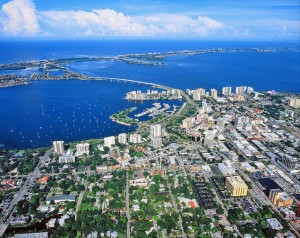Buyers feel a new sense of urgency
A Realtor with Michael Saunders & Co. since 1982, Michael Moulton specializes in luxury waterfront real estate. Within the past decade, he has been involved in transactions exceeding $300 million.
He likes to work both sides of the market, representing buyers and sellers; and he keeps a close eye on trends.
Correspondent Chris Angermann interviewed him at his office on Longboat Key.
Q: What has the luxury real estate market been like?
A: Fun. I’ve had the best summer in my career. I have a $6 million piece of vacant land on Longboat under contract at full price, and I have multiple offers. I typically sell as much real estate in summer as I do in season. It’s a bit more relaxed. The people you work with are here to buy. They’re not tire-kickers.
There’s a mentality that sellers are more willing to negotiate after season than during season, even if that’s not really the case.
Also, we don’t have people coming in and wanting to buy everything on a fire sale in Florida now. We don’t have people talking so much about short sales or saying, “I want a deal.” It’s more like “I’ve got to find a property.” The whole dynamic has changed.
Q: Why do you think that is?
A: Baby boomers, people in their 50s, are realizing we’ve hit the bottom; our prices are coming up again.
They’re buying properties now, even though they’re probably not quite ready to retire. They may rent them out, but they know they’ve got a foothold in this market and in an area where they want to eventually settle.
I’m convinced a part of what’s fueled this development is that properties are selling all over the country again. The people I meet have sold their beach home; they’ve sold the ski home they never use anymore; they’ve sold their main residence up north they couldn’t sell for five years. It’s given them the capital to come here and buy.
Q: Are there any trends as far as what people are looking for?
A: One of the biggest trends is open planning — open space, open kitchen to the living area. That’s very popular, certainly in the new buildings, or in old condos where the interior walls have been taken down. Another trend is outdoor living, whether it’s covered or al fresco kitchens or fire pits. No doubt about it, the world has gotten more casual.
I always tell clients, “You need to decide what is a must-have, want-to-have, and then the tradeoff.” And then either they’ve got to step up to the plate with more money, or they’re going to have to back off something.”
My job is to help educate them to go to through the process. I recently showed properties to a 50-something customer from New York who was probably going to spend up to $2 million, and the house he most liked was not on the water. For a couple million, a beautiful house versus a house on the water that’s not quite as nice and in not as good a neighborhood. So, he’s having to wrestle with how important it is for him to be on the water.
Here’s an interesting dynamic. I’ve had several transactions where people bought the property sight-unseen. I’m talking some expensive stuff, too.
Q: How does that work?
A: Computers and the Internet make that possible. People have so much information at their fingertips now, when they call about a property, they sometimes know more about it than I do. I can quickly get up to speed and take a look at it, and then get on the phone with them and walk them through what the pictures really are telling them — is the room bigger or smaller, where is it in relation to the next room, what are the finishes really like, what’s the view out that window?
I don’t sugarcoat things, either. For one downtown condominium, a million-dollar deal, I said to the clients, who hadn’t seen it, “You’re going to gut this place. It’s the space you want, and the view is amazing.”
When they came to the town after the closing, I didn’t hear from them for 24 hours, and I thought, “Oh my god, they’re devastated.” They called me the next day and said, “Michael, we are absolutely beside ourselves … with joy! This is everything you said and more!”




